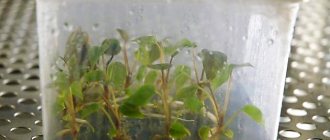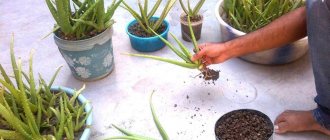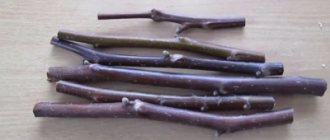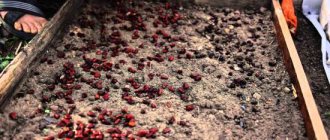Pros and cons of rose cuttings
Cuttings are an artificial method of vegetative propagation of rose bushes, which is suitable even for novice gardeners. At the stages of processing the separated part of the stem and its rooting, you need to show a little patience. After which all that remains is to plant the seedling on the plot and wait for the fruits of your labor.
Roses that take root best are those that are red or pink in color.
Pros of growing new rose bushes from cuttings:
- 100% protection against counterfeiting - a visual inspection of an adult plant allows you to assess the future result in advance.
- Lack of wild growth - the crop does not degenerate into rose hips, which makes caring for it much easier.
- Minimum costs - you can get a large amount of planting material from one parent, which eliminates the need to purchase expensive seedlings.
- A high percentage of positive results - only 15–20% of stems with well-developed roots subsequently do not take root in open ground.
- Longevity of the rose garden - self-rooted shrubs, especially uncovered shrubs, can live for several decades.
- Variety of options - most roses lend themselves well to cuttings, including climbing, miniature, groundcover, hybrid-polyanthus, polyanthus and certain hybrid tea species.
You can easily bring cuttings of your favorite rose variety with you from a trip, as they tolerate long journeys well. To do this, they need to be properly prepared: stick the sharp end into raw potatoes, wrap them in paper and cover with a layer of polyethylene with holes. This design can be stored for up to 1 month at a temperature of +2–4 °C.
Cons of growing new rose bushes from cuttings:
- The impossibility of predicting results when propagating vegetatively grafted (hybrid) varieties. Basically, the qualities of only the plant from which the root system was developed are inherited.
- Difficulties in growing some species. Remontant, yellow and wrinkled park roses are the worst to grow in this way.
Also a relative disadvantage is the weak frost resistance of roses propagated by cuttings, but the peculiarity of such plants is that when the surface part freezes, it is able to self-regenerate from dormant underground buds (which does not happen, for example, in grafted flowers).
How to care for planted cuttings
Young roses that have taken root in open ground are covered with a mound of earth 10 to 20 cm high. This creates a permanent mound, allowing the plant to form several levels of roots and protecting the original cuttings. Carry out regular watering and fertilizing of the root zone of the plant. Nutrient mixtures are applied after the main watering into small holes slightly away from the root system. During the summer season, complex fertilizers are used no more than once a month.
The soil around the rose bushes must be weeded and loosened to ensure soil heating and air exchange. Root and shoot growth will occur more actively in warm soil than in cold soil. When the temperature drops, plants absorb moisture poorly, slowly increase their green mass, and do not form flower stalks. Without proper care, it is impossible to obtain strong rose bushes, despite all the efforts that were made in the previous stages of propagation of cuttings.
Rose in the garden
Such beautiful flowers as roses rightfully occupy the most honorable place in personal plots and under the windows of high-rise buildings. The cheapest and easiest way to solve the question of how to propagate roses from cuttings at home is to not doubt your abilities and take on this work.
Selection of starting material for germination
To avoid disappointment and not waste time on obviously unsuccessful options, you need to make sure in advance that the roses you like are suitable for obtaining high-quality cuttings.
Tips for choosing rose bushes suitable for cuttings:
- Do not cut shoots from too young, flexible or, conversely, very old woody plants.
- Refuse to propagate recently imported species.
- Give preference to domestic varieties or flowers that have undergone long-term acclimatization.
- Select only healthy and strong medium-sized shrubs without external signs of wilting, damage and/or disease (spots, mold, etc.).
It is necessary to prepare the bush for propagation by cuttings in advance by applying fertilizers to it.
An important indicator of readiness for reproduction is the presence of easily breaking off thorns - this indicates sufficient maturity of the parent rose.
Caring for roses after planting
After planting, roses must be watered, and the ground is sprinkled with large sawdust to retain moisture. At first, the bushes protect from exposure to direct sunlight. Adaptation of seedlings planted from pots to the street lasts about two weeks, then they begin to grow.
Fertilizer is required only for seedlings that have grown in height by more than 12 cm. Complex liquid solutions or infusions of mullein and herbs are used for feeding. In order for the garden plant to be strong, in the first year after planting, the buds are cut off, allowing the bush to direct all its forces to the formation of stems. In the autumn-winter period, young bushes must be covered, protecting them from severe frosts.
If the above conditions are met, in 2-3 years you can use cuttings to plant a gorgeous flower bed in the garden without spending money on buying seedlings in the store.
Taking cuttings: when and how to cut shoots correctly
If you wish, you can try to grow a rose from a cutting, even from unpresentable branches. For example, those that broke off under the weight of snow or remained after trimming a bush. However, to obtain the most favorable results, it is recommended to adhere to certain rules:
- Season. Experienced flower growers advise cutting shoots during the period from the formation of buds to the end of flowering, i.e. from early summer to mid-autumn. By this time, the wood will have accumulated enough nutrients, but in general, you can start rooting in early spring.
- Maturity stage. A suitable cutting is considered to be a small straight section of an adult semi-lignified (this year) green stem with 2–5 fully formed axillary buds.
- Escape size. The length should be from 15 to 30 cm, thickness - from 5 to 10 mm.
- Work tool. A special garden pruner or a household knife with a very sharp blade will do (the main thing is to make sure that it accurately separates the trunk and does not flatten or “shag” it). It is advisable to disinfect the instrument with alcohol or boiling water.
- Place of cut. For cuttings, the middle or lower part of the stem is used (the top takes root very poorly). The upper cut is made in a straight line between the buds 2–6 mm above one of them, and the lower cut is made obliquely, at an angle of 45° directly below the outermost bud.
- Material processing. At the base of the finished cuttings, you need to completely remove the thorns and leaves, and reduce their number by half on top.
It is better to carry out cuttings during the period when the buds of the mother specimens are colored.
Important! If the branches, when probed, turn out to be insufficiently elastic or even sluggish (which may be evidence of a disease), then they should not be used for propagation: at best, they simply will not take root, and at worst, they will infect healthy neighbors.
You can complete the preparation of the stem by dipping the cut areas in a weak (light pink) solution of potassium permanganate for disinfection. To minimize moisture loss, seal the upper end with wax or paraffin, and place the lower end in a stimulating solution.
By cuttings
According to many gardeners, cuttings are the easiest way to propagate roses even for a novice gardener.
In this case, to carry out the procedure, you can use miniature, climbing, polyanthus roses, as well as some types of Floribunda.
Cuttings have a number of advantageous features:
- large selection of planting material;
- low material costs;
- little time investment.
What cuttings can be taken for rooting?
For propagation, semi-lignified and lignified cuttings are used. In the first case, healthy and well-developed plants are used for harvesting, exclusively the middle part of their shoot, at least 5 mm thick. Cutting of planting material occurs during active budding, when the stem at the base gradually becomes woody, and the bend is accompanied by a characteristic crack.
Rooting of cuttings, for which long shoots with flowers or buds were used, proceeds a little worse. Cuttings from young, green, not quite mature stems, as well as from their apical part with buds, will be unsuitable.
When preparing adult rose bushes for winter, cut off their top part. Thanks to this procedure, you can provide yourself with high-quality planting material in sufficient quantity.
To harvest woody cuttings, use shoots whose thickness does not exceed the thickness of a pencil, which will improve their survival rate.
High-quality planting material should have from 3 to 5 buds.
In the upper part, the cut is made at a right angle. The bottom is cut at an angle.
Garden tools used for cutting and preparing cuttings must be well sharpened and also disinfected in an alcohol solution or boiling water.
Preparing the substrate for cuttings
The soil for rooting is prepared in advance. For rose cuttings, make up a mixture that includes:
- leaf soil (1 tsp);
- turf (2 hours);
- sand (1 tsp);
- wood ash (1/2 cup).
This substrate is characterized by breathable properties, which is very important for the growth of the root system.
To improve drainage qualities, river sand is used, which is sprinkled on top of the prepared soil for the rose.
Cutting process
Cuttings of roses are carried out in many ways. But every experienced rose grower has his own method, which he considers the most effective and simple.
In potatoes
When preparing the cuttings for planting, they are treated in a solution of potassium permanganate. Then place it in a solution with aloe juice for 12 hours. Medium-sized potatoes are washed and dried, and the eyes are carefully removed. The prepared planting material is immersed inside and placed in a dark place, covered with a glass container to create a greenhouse effect. Watering is carried out once every 7 days. As soon as roots appear, the jar cover is removed.
Burrito Method
Using this method may not provide 100% rooting; the yield of high-quality seedlings is very small. Because of this, it is more often used by passionate flower growers and experimenters.
Cuttings using the Burrito method are in little demand among flower growers, but are distinguished by their simplicity of operation. The lower part of the prepared planting material is treated with growth stimulants, then wrapped in moistened thin paper (newspaper) and placed in a dark place for 2 weeks, stored at a temperature of 15 to 18° until roots appear.
Trannoy method
This method “under glass containers” is very popular among gardeners. In June-July, shoots are selected that are suitable in length for cuttings. Planting material of 20–25 cm is prepared from them, all leaves are removed, leaving a couple on top. Planted immediately at the growing site in a well-lit area.
The cuttings are immersed in the ground at an angle of 45° and covered with a glass jar or plastic bottle. If several pieces are planted in one planting hole, be sure to plant the rooted cuttings in separate holes. They require regular watering and mandatory loosening of the soil to improve the supply of oxygen to the roots.
In water
For the procedure, boiled or distilled water is used, poured into a transparent glass container where the prepared cuttings are placed. The jar is placed in partial shade, away from sunlight. The water is topped up or changed every two days. After 1 month, when the first roots appear, they are planted in the soil and covered with jars until the leaves appear.
Rooting in a greenhouse
Cuttings for rooting can be planted in a small greenhouse. Its preparation should be started 4 weeks before the expected time of the procedure. The greenhouse is placed in an open and slightly darkened area. Groundwater in this place should be at a distance of 2 meters from the ground surface.
Dig a hole to an arbitrary length and 0.5 m deep, up to 1.5 m wide. Fresh manure is placed there at 2/3 of the depth and covered with film on top. Over the course of two weeks, the temperature in the greenhouse will rise and the soil will gradually shrink.
After removing the film, the manure is covered with turf soil, leaf soil and purified sand in a ratio of 2:1:1 or fertile soil mixed with peat in a ratio of 1:1. Clean sand is placed on top 3–5 cm, and the prepared soil is watered abundantly.
The cuttings are planted to a depth of 2 cm at a distance of 5 cm from each other, between rows - up to 10 cm. You just need to make sure that the cut of the lower part is in the soil and not in the sand.
The planted cuttings are watered with water, and the greenhouse is covered with film.
This method is considered the most effective, since such a cover is quite airtight and the water will not evaporate very quickly.
Caring for cuttings in winter
When frost approaches, grown plants should be moved to a room where a certain level of humidity is established. After a successful wintering, in the spring they are planted in the flower garden in a permanent place.
You can keep the cuttings in a warm, dry shelter, then the plants are not transferred anywhere, and are covered with mulch.
Autumn planting and growing
Flower growers often use a method that allows them to root roses in the fall. The prepared cuttings are planted in an open bed at an angle, where a shelter is provided to protect them from extreme cold.
In the spring, this cover is removed, opening the garden bed, and the rose bushes are grown in natural conditions. Transplantation to a permanent place is carried out next autumn.
Application of a growth activator
For more stable rooting of rose cuttings, they are soaked for 10–24 hours in a weakly concentrated solution of any growth stimulator (regulator), which can be either professional or homemade.
Table: Means for enhancing root formation.
| Drug name | Active substance | Concentration per 1 liter of water, g/ml | Cost of 1 liter of ready-made solution, rub. |
| Heteroauxin, Cornerost | Indolylacetic acid | 0,2 | 30 |
| Kornevin | Indolylbutyric acid | 1 | 2 |
| Epin-Extra | Epibrassinolide | 0,2 | 5 |
| GO Bio Root Plus | Vitamins, enzymes, organic and humic acids | 5 | 16 |
| Zircon | Hydroxycinnamic acid | 1 | 20 |
| Etamon | Dimethylammonium dihydroxyethyl phosphate | 0,1 | 3 |
Preparing the solution at home:
- Willow infusion. Place several willow twigs in ordinary clean water and wait until they take root. After this, the nutrient liquid can be drained.
- Honey water. Dissolve 1 tsp. honey in 0.5 liters of warm boiled water.
- Yeast extract. Dilute raw baker's yeast in clean warm water at the rate of 100 g per 1 liter, and the effect can be enhanced by adding 1 tsp. Sahara.
- Aloe juice (gel). Grind the required amount of aloe leaves in a blender and strain the resulting pulp through several layers of gauze to separate the concentrated juice.
The use of growth activators contributes to the formation of a more powerful rose root system
Advice. The cuttings can be left in pure gel from aloe leaves for 10–12 hours, after which it is advisable to dilute the juice with water (1:9) and leave it in this form for another 10–12 hours or for the entire period of development of the root system (with the water method of cuttings ).
The choice of growth activator depends on the capabilities and desires of the grower, but it is worth noting that the action of chemical agents is more targeted than that of its natural analogues. Already on the 12th–15th day of using these drugs, the cuttings develop their own root system (versus the standard 30 days). It is also necessary to remember that when working with chemicals, it is very important to comply with the permissible concentration indicated on the packaging and precautions.
In the package
For cuttings of roses, plastic bags are used. They are filled with sterile purchased soil, and wet moss soaked in aloe juice is added. All components are mixed.
A cutting prepared in the standard way is placed in the bag. The bag is tied, after which the resulting structure is hung on the street. A humid atmosphere is created inside, which promotes rapid rooting of sprouts. Within a month they can be planted in open ground. This unusual propagation technology is popular among gardeners!
Ready to plant in open ground
The period of readiness of pink cuttings for planting in an open garden plot depends on the stage of its development and the degree of warming of the soil. The type of formation of the root system is also taken into account:
- Open (for plants in newspapers, bags, water, etc.). The size of the roots is from 5 to 7 cm, the optimal time is from mid-April.
- Closed (for seedlings in pots, substrates, biodegradable containers, etc.). New leaves from 2 to 6 pieces, the optimal time is the first ten days of May.
Important! If there are young green leaves, the time of planting in open ground is selected especially carefully: it is necessary to exclude any possibility of night frosts.
Spring is the most favorable time for planting. It is advisable to actively care for young cuttings for another 1–2 months so that developmental deviations can be corrected. However, in the southern regions, planting can be done in the fall.
In order for the seedlings to become well established and bloom regularly in the future, care must be taken to protect them from cold and possible frosts.
It is necessary to prepare the soil for planting in advance so that it has time to settle before planting.
The most widespread are 3 methods of insulation:
- Sprinkling and watering. Prevents cracking of the trunk, because it forms an ice “shell” on it, increasing the thermal conductivity and heat capacity of the earth. The sprinkling procedure must be repeated every half hour. It can be quite difficult to manually spray leaves and stems repeatedly over several hours at night. Therefore, an automatic irrigation installation is more suitable for this method. A positive effect is produced not only by the formed ice shell, but also by the heat generated: when 1 gram of water freezes, 80 calories of energy are produced, which literally warms the seedlings.
- Smoke (fumigation). It has a direct heating effect and reduces the radiation of heat from the soil through an artificial smoke cloud. Instructions for smoke (fumigation) of the area:
- Assemble a “three-layer cake” (height - 1 m, width - 1.5 m) from materials that can smolder with low combustion: 1 layer - firewood and brushwood; 2nd layer - straw, manure and dry leaves; 3rd layer - earth (2–3 cm).
Place such blanks throughout the entire area in need of heating (1 pile per 10 m2).
- Make holes in the earthen layer from above and on the leeward side for better smoke escape.
- Set fire when frost occurs.
- Creation of shelters. Retains heat by providing a physical barrier between plants and the environment. A variety of materials are suitable for creating shelters: polyethylene film and agrofibre;
- glass, including individual domes (cans);
- mulch (straw, crop residues, pine spruce branches, paper, cardboard, leaves, undecomposed compost);
- improvised devices (plastic bottles, boxes, containers, etc.).
Such smoke piles are designed to smolder for 15 hours, which is enough to survive one frosty night.
Covering roses is carried out in late autumn
Important! If the weather permits, then in the daytime it is better to remove opaque covers to give the plant access to sunlight.
When planting a rose in the autumn, it is important to choose the right time so that the seedling has time to take root in a new place, but does not begin to actively grow before the arrival of frost.
In this case, you will have to focus on the local climate. It is necessary to take into account that rooting usually takes about 1–1.5 months.
Due to the large variation in time, novice gardeners are advised to still overwinter it in room (basement) conditions, and begin planting next spring.
Growing roses
Having selected a high-quality seedling and planted it according to all the rules, you should continue to follow the rules for caring for and growing hybrid tea roses.
- Watering
Hybrid tea rose needs systematic watering. Drying out immediately affects the condition and development of the plant. Its flowers become smaller and its leaves dry out. Overmoistening is also undesirable, as it can lead to fungal diseases. Optimal watering regime: abundant watering once every 7 days in summer, in hot weather. In spring and autumn, the plant is watered less often - once every 1.5 - 2 weeks.
- Mulching
Mulching will help maintain sufficient soil moisture. It is best to use humus or peat as mulch.
- Top dressing
For normal development and abundant long-term flowering, hybrid tea roses require constant feeding. Today it is best to use special complex mineral fertilizers, which contain the chemical elements necessary for the flower: potassium, magnesium, phosphorus.
Fertilizing is carried out in the spring, during plant growth (the first is nitrogen, the second is potassium), then at the time of budding, then after the first flowering. In summer it is useful to combine the use of mineral and organic fertilizers. In the fall, phosphorus-potassium fertilizers are applied to prepare the plants for the winter.
Video “How to water roses correctly”
Preparing a place for planting seedlings
To choose the most suitable planting site, you need to focus on the individual needs of the varieties:
- Light-loving plants are located in open, elevated spaces.
- Shade-loving plants can be planted near fences, trees and other voluminous shrubs. They are also great for creating a hedge around the perimeter of the site.
Preparing the soil before planting rose cuttings is carried out in 2 stages:
- In 1–3 months, dig up the soil to a depth of about 55 cm. Add a mixture of sand, clay and compost (1:1:2) and loosen it;
- Immediately before planting, partially replace the soil in the place of permanent growth with a fresh mixture consisting of turf, humus and sand (2:1:1).
Advice. It is recommended to pay attention to the original soil type. Loamy soil needs minimal preparation, while clayey soil often has a high level of acidity (pH < 5.5), which it is advisable to neutralize with a weak solution of slaked lime.
Let's get acquainted: hybrid tea rose
Hybrid tea rose variety Watercolor
People have been admiring hybrid tea roses for 150 years. This class of flowers is the result of breeding work that combined remontant and tea roses.
The bred roses have attracted attention for their ability to bloom several times per season, obtained from remontant roses. And the teahouses imparted to the new class varieties the delicate aroma of tea leaves after picking, as well as the beautiful shape of the flower.
Selection work on hybrid tea roses was not interrupted. Their advantages became more and more. Varieties of this class have become resistant to diseases and can better withstand frosty winters.
When describing their favorite plants, professionals pay attention to large flowers, abundant flowering, and delicate aroma. By listening to the advice of experts who talk about the hybrid tea rose, the features of its planting and care, you will make your flower garden unique!
More details Varieties of hybrid tea roses
Planting a germinated cutting in a permanent flower bed
Instructions for transplanting a strong rose cutting to a garden plot:
- Dig the appropriate number of holes at an acceptable (depending on the variety) distance from each other:
- short - from 30 to 40 cm;
- tall - from 50 to 60 cm;
- climbing - from 100 to 200 cm.
- Carefully remove the cutting from the improvised incubator, being careful not to damage the roots.
- Lower the shoots into the prepared holes by 10–15 cm and cover the top with a mixture of soil and compost.
- To avoid rotting, water the soil with a weak solution of potassium permanganate.
If you plant roses too thickly, it will lead to the development of diseases.
If the buds on the seedlings have only hatched a little, then they do not need to be covered. If the buds and leaves are already formed, then they should be protected from sunburn with Lutrasil or Spunbond.
It is better to plant seedlings in cloudy weather or late in the evening, when the sun's rays are not so active.
When decoratively planting climbing or climbing roses, holes should be dug at a distance of about 18–20 cm from the supporting structure (trellis, fence, etc.).
A climbing rose along the fence will enliven the hedge
The seedlings themselves should be tilted towards the support. You also need to take into account that if the decorative object has a solid surface, then a lattice base must be attached to it at a distance of 7–9 cm from the wall in order to provide ventilation and access to the plant.
After transplanting future rose bushes to a permanent place, caring for them is no different from caring for other flowers. They need regular watering, fertilizing and loosening the soil.
Advice. In order for the young plant to grow well, it is better not to allow it to bloom in the first 1–2 years after planting the cuttings: for this, immature buds are pinched off at the very initial stage of formation.
Cuttings are rightfully considered one of the most popular methods of propagating roses. If you follow all the proposed rules, the effectiveness reaches 80–90%. This is a very high figure for the rose family.
- Author: Eudaimonia
Rate this article:
- 5
- 4
- 3
- 2
- 1
(40 votes, average: 4 out of 5)
Share with your friends!
Methods for rooting cuttings
Episcia - home care, propagation by leaves and cuttings
Even the absolutely correct execution of step-by-step instructions on how to grow roses does not always lead to a good result. With summer and autumn rooting of pink shoots, it is possible to obtain normal roots in 80-90% of cases; spring attempts lead to 50% results; in winter, roots will grow on 30% of prepared branches. Therefore, it is necessary to try to root as many cuttings as possible.
Rooting in water
Use settled tap water or spring or rain water purified from natural impurities. It is poured into a clean transparent container. Add 1-2 tablets of black activated carbon to the water. The cuttings are lowered so that the water covers the stems 2-3 cm above the lower bud. Rose leaves should not touch the water.
The jar is covered with a cover made of a plastic bag or a plastic bottle cut off at the bottom. The plants should not be exposed to direct sunlight, but cuttings will not reproduce without light. As the amount of moisture in the jar decreases, water is added or completely changed.
In water
Roots germinated in this way will be very fragile, poorly protected from damage and disease, and poorly adapted to development in a denser environment. They are transplanted into the soil to a permanent place of cultivation with caution. The substrate must be nutritious, loose and constantly moist. The length of the roots should not exceed 5 cm.
Planting rose cuttings in potatoes
Rooting roses using large potatoes is advantageous because the tubers are saturated with moisture, minerals and starch, which guarantees a high percentage of full-fledged seedlings. All eyes are cut out from potatoes. This is necessary so that the root vegetables completely give up all their nutrients to the flowers.
Holes are made in the potatoes into which the lower ends of the cuttings fit tightly and rose cuts are inserted. Potatoes must be placed in a nutrient substrate at a depth of 15 cm. The soil must completely cover the tuber and reach the level of the stem. The soil is well compacted in the area where the seedling is placed. Watering should be regular, but excessive waterlogging should not be allowed.
In potatoes
Rooting cuttings in a bag
This technique is used in residential settings. Use flower pots with drainage, moist fertile substrate or sphagnum moss placed at the bottom. The moss is soaked in freshly squeezed aloe juice diluted in water. Use 1 part juice for 9 parts liquid. Flowers are placed in pots, covering and compacting the lower parts of the stems with soil mixture.
The pots are placed in transparent plastic bags, which are tied tightly, first filled with air exhaled by the person. The packages are placed in a well-lit, warm, but not hot place. Periodically check the condition of the substrate and, if necessary, moisten it.
In the package
Roses from bouquet cuttings
Propagating roses by cuttings from a bouquet also gives good results, but only if your roses are of domestic origin. The fact is that luxury imported roses are treated with preservatives before being sent to other countries, so they are no longer capable of producing roots. There are a few more points you should know:
- root roses from a fresh bouquet;
- choose a slightly lignified stem for rooting;
- the cutting should be of medium thickness with buds at the top and bottom (cut the rose stem into the cutting as described in the previous paragraphs).
If you decide that you want to root roses from a bouquet given to you, donate them immediately, while the roses are fresh: remove all flowers and buds from them, all thorns, cut cuttings from the stems 15-30 cm long, removing the leaves at the bottom and shortening them in half third the leaves at the top, and place the cuttings in a vase with distilled water. Change the water regularly until roots appear on the cuttings, then transplant them into a pot or soil under a jar (depending on the time of year) in the manner that has already been described.
Listen to the article
Many gardeners have tried to grow roses from cuttings, but not all have achieved success. We will introduce you to several ways to grow roses from cuttings and hope that this knowledge will help you become more successful in breeding these truly royal flowers. Propagation of roses by cuttings gives a much more reliable result than grafting or seed propagation, due to its simplicity and the ability to carry it out at any time of the year, since not only spring shoots of a rose bush are suitable as cuttings, but also stems of roses from a bouquet given to you...











